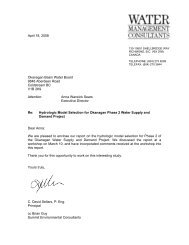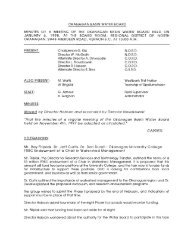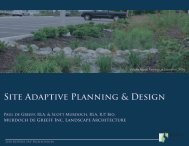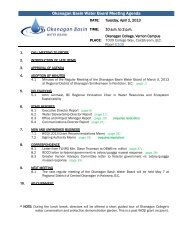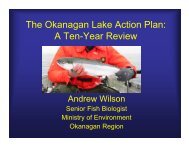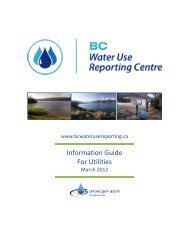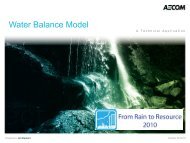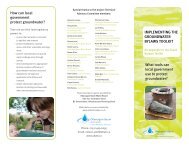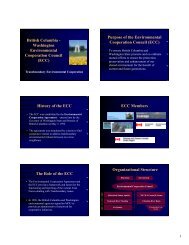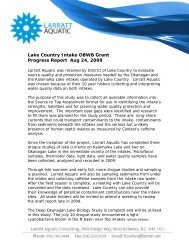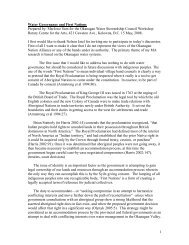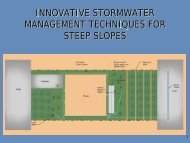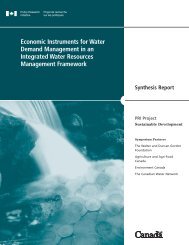Instream Flow Needs Analysis - Okanagan Basin Water Board
Instream Flow Needs Analysis - Okanagan Basin Water Board
Instream Flow Needs Analysis - Okanagan Basin Water Board
- No tags were found...
You also want an ePaper? Increase the reach of your titles
YUMPU automatically turns print PDFs into web optimized ePapers that Google loves.
FINAL<strong>Okanagan</strong> <strong>Basin</strong> <strong>Instream</strong> <strong>Flow</strong> <strong>Needs</strong>Executive SummaryThe <strong>Okanagan</strong> River and tributary streams throughout the basin provide critical spawning and rearinghabitat for salmon, trout and other resident fish species. As a result of increasing water demands, dams forflood control and continuing land development, fish habitat in many subbasin watersheds has beenimpacted or even eliminated. The <strong>Okanagan</strong> <strong>Water</strong> Supply and Demand Project was initiated in responseto increasing concern over the remaining amount of surplus water available for continued growth and theimpacts of climate change on water supplies and environmental water needs. A major task within ourinstream flow needs (IFN) project was to use modeled information on “naturalized flows” 1 to determineIFN for fish and other aquatic biota at specific areas (called “nodes”) that have been defined for the<strong>Okanagan</strong> <strong>Water</strong> Supply and Demand Project. These nodes consist of key tributary mouths, mainstemlakes, and key locations along the <strong>Okanagan</strong> River. For the first time, this report documents acomprehensive approach for defining basin-wide default instream flow needs where site specific data onbiophysical linkages does not exist. The approach uses a combination of two peer reviewed IFNmethodologies for standard setting that are accepted in the scientific literature and supported by provincialand federal government biologists. Where available, these “default” guidelines are supplemented byinstream flow recommendations that currently exist following site-specific IFN studies or water useplanning agreements.Our first IFN method was the Hatfield and Bruce (2000) meta-analysis approach, based on over 1500habitat vs. flow curves from 127 physical habitat simulation (PHABSIM) studies throughout westernNorth America. We used this method to generate regression-based predictions of optimal flows forspawning and rearing of kokanee, sockeye, rainbow trout, steelhead, Chinook and coho salmon. Whilethis approach helps to define optimal flows for rearing/spawning salmonids, it does not assess requiredflows for other fish species, other biota, wetland linkages, channel evolution, etc. Therefore weincorporated BCIFN Phase II instream flow guidelines to generate minimum flows required for broaderecosystem needs (Hatfield et al. 2003). The BCIFN method estimates minimum flow thresholdsthroughout the year to maintain the key features of a particular stream’s natural hydrograph and minimizerisk to fish and other aquatic biota. The BCIFN approach also caps recommended extraction/allocation ofwater from a stream at a defined threshold (a maximum diversion rate). We subtracted this recommendedmaximum diversion rate from the weekly naturalized flows to calculate a recommended watershedconservation flow. The intent of watershed conservation flows is to ensure sufficient water remains in thestreams during the high flow months to fulfill geomorphic needs and promote broader ecologicalfunctions. <strong>Water</strong>shed conservation flows are required in roughly one in five to one in ten years.The instream flow recommendations in this report are largely based on the needs of fish, especially“sentinel” indicator species (e.g., kokanee, sockeye, rainbow trout). Thus, the instream flowsrecommended do not represent a true ecosystem assessment for all types of aquatic and riparianorganisms. Such an undertaking would require a much larger project, one that included considerable timeand resources for field assessments and monitoring. We have however made an effort to consider how ourdefault guidelines do or do not support the requirements for a number of other aquatic-dependentorganisms which are federally or provincially listed as species of concern.Another important feature of this report are alternative IFN “scenarios”, which represent different mixesof IFN method, focal species/life-stage and risk tolerances. For example, Chinook and coho salmon IFN1 These italicized items are defined in the glossary on page xiiESSA Technologies Ltd. &Solander Ecological Research



